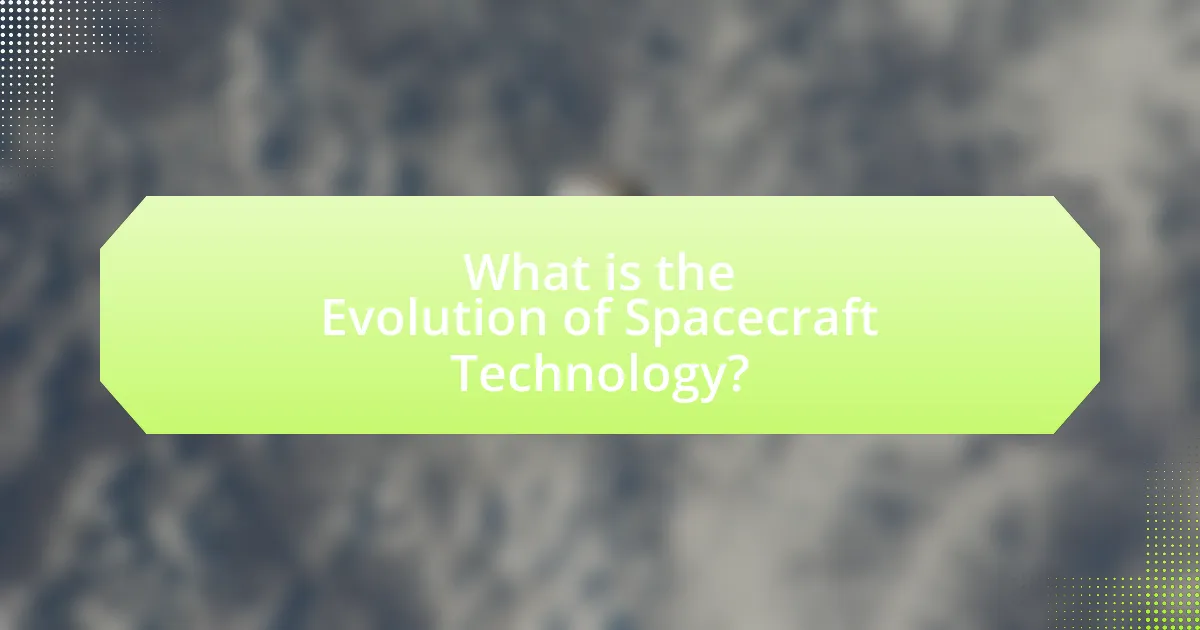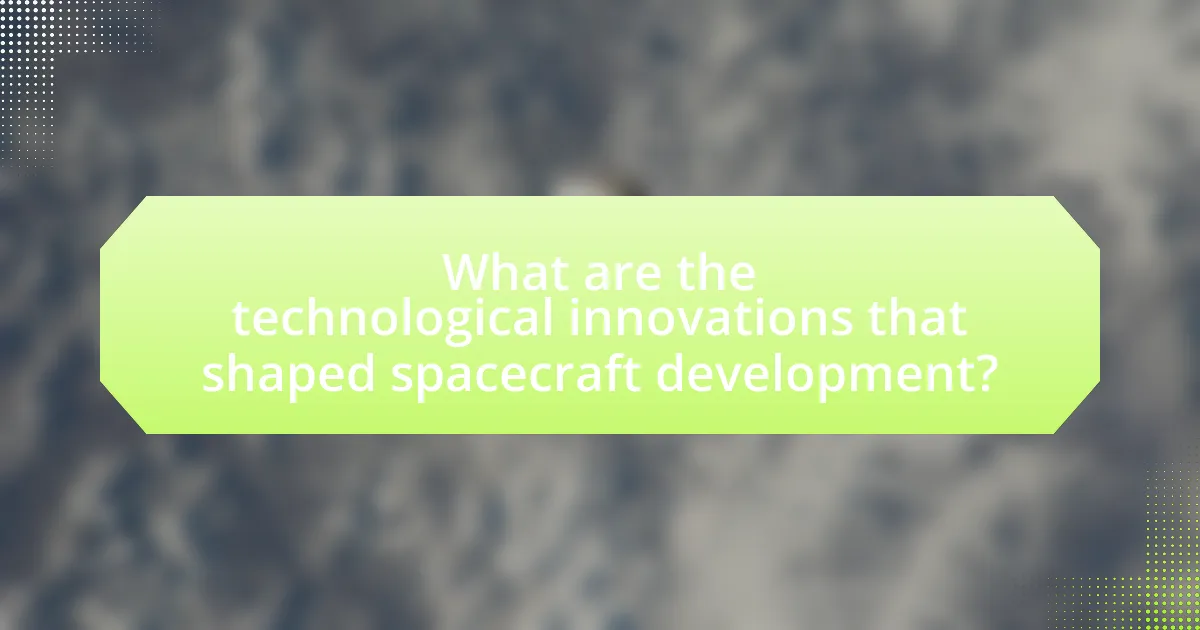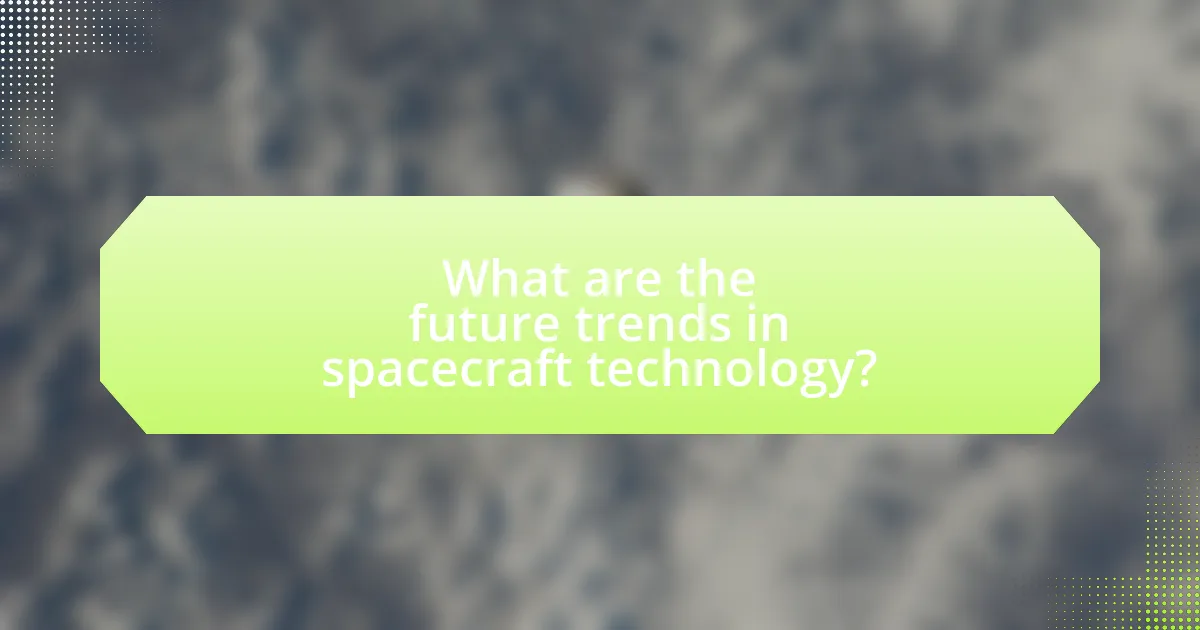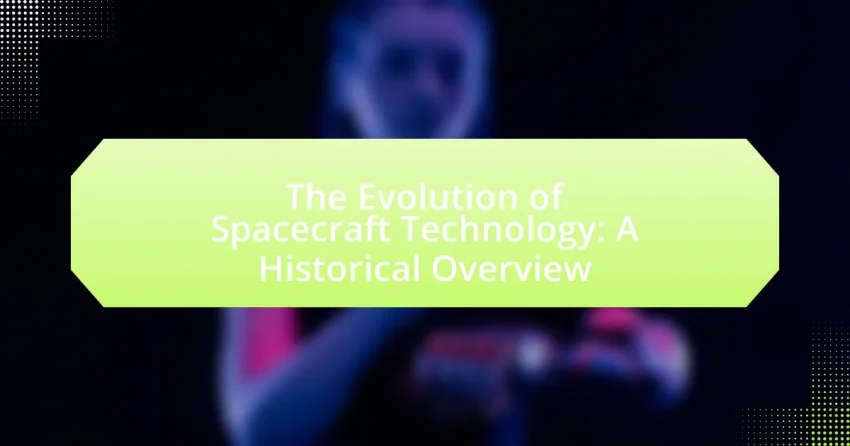The article focuses on the evolution of spacecraft technology, tracing its development from early designs like the V-2 rocket to modern advancements in commercial spaceflight. Key milestones include the launch of Sputnik 1, the Apollo Moon landing, and the introduction of reusable spacecraft such as the Space Shuttle. The article discusses the impact of the Cold War on technological advancements, the emergence of various spacecraft types, and the role of robotic missions in expanding our understanding of the universe. Additionally, it highlights innovations in propulsion systems, materials science, and the influence of private companies on the future of space exploration. The article concludes by addressing challenges and environmental considerations for upcoming missions.

What is the Evolution of Spacecraft Technology?
The evolution of spacecraft technology encompasses significant advancements from early designs to modern spacecraft. Initially, the V-2 rocket, developed by Germany during World War II, marked the first human-made object to reach the edge of space in 1944. Following this, the launch of Sputnik 1 by the Soviet Union in 1957 represented the first artificial satellite, initiating the space race and leading to the development of more sophisticated spacecraft.
In the 1960s, NASA’s Apollo program successfully landed humans on the Moon, showcasing advancements in life support systems and navigation technology. The introduction of reusable spacecraft, such as the Space Shuttle in the 1980s, further revolutionized space travel by reducing costs and increasing access to space.
The 21st century has seen the rise of commercial spaceflight, with companies like SpaceX developing reusable rockets, exemplified by the Falcon 9, which has significantly lowered the cost of launching payloads into orbit. Additionally, advancements in satellite technology, such as miniaturization and improved communication systems, have enhanced global connectivity and Earth observation capabilities.
Overall, the evolution of spacecraft technology reflects a trajectory of increasing complexity, efficiency, and accessibility, driven by both governmental and commercial interests in space exploration.
How has spacecraft technology developed over time?
Spacecraft technology has developed significantly over time, evolving from basic designs to advanced systems capable of deep space exploration. Initially, during the 1950s and 1960s, spacecraft like Sputnik and Mercury were designed for simple missions, focusing on low Earth orbit and basic human spaceflight. The Apollo program in the 1960s marked a major advancement, enabling humans to land on the Moon and return safely, showcasing capabilities in navigation, life support, and propulsion.
In the following decades, the introduction of space shuttles in the 1980s allowed for reusable spacecraft, enhancing mission flexibility and reducing costs. The development of robotic spacecraft, such as Voyager and Mars rovers, expanded our reach to other planets, providing valuable data about the solar system. The 2000s saw the rise of commercial spaceflight, with companies like SpaceX and Blue Origin innovating launch technologies and reducing barriers to entry for space exploration.
Recent advancements include the use of artificial intelligence for autonomous navigation and the development of advanced propulsion systems, such as ion thrusters, which improve efficiency for long-duration missions. These technological milestones demonstrate a continuous trajectory of innovation, driven by both governmental and private sector initiatives, leading to a more capable and accessible space exploration landscape.
What were the key milestones in the early stages of spacecraft technology?
The key milestones in the early stages of spacecraft technology include the launch of Sputnik 1 in 1957, which marked the first artificial satellite in orbit, and the successful flight of Vostok 1 in 1961, carrying Yuri Gagarin as the first human in space. These events demonstrated the feasibility of space travel and initiated the space race. Additionally, the development of the Saturn V rocket, which successfully launched Apollo 11 in 1969, enabled humans to land on the Moon, further advancing spacecraft technology. Each of these milestones significantly contributed to the understanding and capabilities of space exploration.
How did the Cold War influence advancements in spacecraft technology?
The Cold War significantly accelerated advancements in spacecraft technology due to intense competition between the United States and the Soviet Union. This rivalry led to substantial investments in research and development, exemplified by the launch of Sputnik by the Soviet Union in 1957, which marked the beginning of the space race. The U.S. responded with initiatives like NASA’s Apollo program, culminating in the moon landing in 1969. These efforts not only advanced rocket propulsion, satellite technology, and human spaceflight but also fostered innovations in materials science and telecommunications, driven by the need for superior military and strategic capabilities. The Cold War context created a sense of urgency and priority for space exploration, resulting in technological breakthroughs that laid the foundation for modern space exploration.
What are the major types of spacecraft that have emerged?
The major types of spacecraft that have emerged include crewed spacecraft, uncrewed spacecraft, satellites, space probes, and space stations. Crewed spacecraft, such as the Apollo Lunar Module, are designed to transport humans into space, while uncrewed spacecraft, like the Mars rovers, operate autonomously or via remote control. Satellites, including communication and weather satellites, orbit Earth and other celestial bodies for various purposes. Space probes, such as Voyager 1, are designed to explore distant regions of the solar system and gather scientific data. Space stations, exemplified by the International Space Station, serve as habitable artificial satellites for research and international collaboration in space. Each type has played a crucial role in advancing our understanding of space and technology.
What distinguishes crewed spacecraft from uncrewed spacecraft?
Crewed spacecraft are designed to carry astronauts, while uncrewed spacecraft operate without human presence. The primary distinction lies in the presence of life support systems in crewed spacecraft, which provide oxygen, temperature control, and waste management necessary for human survival. For example, NASA’s Apollo missions utilized crewed spacecraft to transport astronauts to the Moon, incorporating life support systems to ensure their safety. In contrast, uncrewed spacecraft, such as the Mars rovers, are equipped with automated systems and do not require life support, allowing them to operate in environments unsuitable for humans. This fundamental difference in design and functionality highlights the unique requirements of human spaceflight compared to robotic exploration.
How have robotic spacecraft changed our understanding of the universe?
Robotic spacecraft have significantly enhanced our understanding of the universe by enabling detailed exploration of celestial bodies and gathering data that would be impossible to obtain through Earth-based observations. For instance, missions like Voyager 1 and 2 have provided invaluable information about the outer planets and interstellar space, revealing the complex atmospheres and magnetic fields of planets such as Jupiter and Saturn. Additionally, the Mars rovers, including Curiosity and Perseverance, have conducted in-situ analyses of Martian soil and climate, uncovering evidence of past water and potential habitability. These findings have reshaped our knowledge of planetary formation and the potential for life beyond Earth, demonstrating the critical role of robotic spacecraft in advancing astrophysical research and expanding our cosmic perspective.

What are the technological innovations that shaped spacecraft development?
Technological innovations that shaped spacecraft development include advancements in propulsion systems, materials science, and computer technology. The development of rocket propulsion, particularly liquid and solid fuel engines, enabled spacecraft to achieve the necessary thrust to escape Earth’s gravity. For instance, the Saturn V rocket, used during the Apollo missions, utilized powerful F-1 engines that produced 1.5 million pounds of thrust.
Materials science innovations, such as the creation of lightweight and heat-resistant materials like carbon composites and titanium alloys, allowed for more efficient spacecraft designs that could withstand extreme conditions during launch and re-entry. The use of these materials was crucial in the construction of the Space Shuttle, which operated from 1981 to 2011.
Furthermore, advancements in computer technology, including the development of onboard computers and software for navigation and control, have significantly improved spacecraft operations. The Apollo Guidance Computer, which was one of the first digital computers used in space, played a vital role in the success of the Apollo missions by providing real-time navigation data. These innovations collectively transformed spacecraft design and functionality, enabling more complex missions and deeper space exploration.
How did propulsion systems evolve in spacecraft technology?
Propulsion systems in spacecraft technology evolved from simple chemical rockets to advanced electric and nuclear propulsion methods. Initially, the V-2 rocket, developed during World War II, marked the first significant use of liquid propellants, enabling higher altitudes and payload capacities. The subsequent development of the Saturn V rocket for the Apollo missions showcased the power of multi-stage liquid propulsion, allowing for deep space exploration.
In the 1970s, the introduction of ion propulsion systems, such as those used in the Deep Space 1 mission, demonstrated the efficiency of electric propulsion, which uses electric fields to accelerate ions, providing continuous thrust over long durations. More recently, advancements in nuclear thermal propulsion have been explored, promising higher efficiency and greater thrust for future missions to Mars and beyond.
These evolutionary steps reflect a continuous pursuit of efficiency, power, and capability in spacecraft propulsion, driven by the need for longer missions and deeper space exploration.
What are the differences between chemical and electric propulsion systems?
Chemical propulsion systems generate thrust through the combustion of propellants, while electric propulsion systems utilize electrical energy to accelerate ions or plasma. Chemical propulsion typically provides high thrust and is used for launch vehicles, exemplified by the Space Shuttle’s main engines, which burn liquid hydrogen and oxygen. In contrast, electric propulsion offers higher efficiency and specific impulse, making it suitable for long-duration space missions, as seen in NASA’s Dawn spacecraft, which employed ion propulsion. The fundamental difference lies in the energy source and thrust characteristics, with chemical systems favoring immediate power and electric systems prioritizing fuel efficiency over extended periods.
How have advancements in propulsion technology impacted mission capabilities?
Advancements in propulsion technology have significantly enhanced mission capabilities by enabling faster travel, increased payload capacity, and extended mission durations. For instance, the development of ion propulsion systems allows spacecraft to achieve higher efficiency and longer operational lifetimes compared to traditional chemical rockets. NASA’s Dawn spacecraft, which utilized ion propulsion, successfully traveled to and orbited both Vesta and Ceres, demonstrating the ability to conduct complex missions that were previously unattainable. Additionally, advancements such as the SpaceX Raptor engine, which employs full-flow staged combustion, have improved thrust-to-weight ratios, allowing for heavier payloads and more ambitious exploration missions. These technological improvements directly correlate with the expanded scope and success of space missions, facilitating deeper exploration of our solar system and beyond.
What role do materials and design play in spacecraft technology?
Materials and design are critical in spacecraft technology as they directly influence performance, safety, and mission success. The choice of materials, such as lightweight composites and heat-resistant alloys, ensures structural integrity while minimizing weight, which is essential for fuel efficiency and payload capacity. For instance, the use of carbon fiber reinforced polymers in the construction of the Boeing 787 Dreamliner has demonstrated significant weight reduction, which is applicable in aerospace applications.
Design plays a pivotal role in optimizing aerodynamics and thermal protection, as seen in the streamlined shapes of spacecraft that reduce drag during launch and re-entry. The design of the Space Shuttle’s thermal protection system, which utilized tiles made from silica fibers, effectively protected it from extreme temperatures during re-entry, showcasing how design and materials work together to enhance safety and functionality.
Overall, the integration of advanced materials and innovative design principles is fundamental to the evolution and advancement of spacecraft technology, enabling more ambitious missions and improving overall efficiency.
What materials are commonly used in spacecraft construction?
Common materials used in spacecraft construction include aluminum, titanium, carbon fiber composites, and various alloys. Aluminum is favored for its lightweight and strength, making it ideal for structural components. Titanium offers high strength-to-weight ratios and excellent corrosion resistance, which is crucial for the harsh environment of space. Carbon fiber composites are increasingly used due to their high strength and low weight, allowing for more efficient designs. Additionally, specialized thermal protection materials, such as ceramic tiles and ablative materials, are employed to shield spacecraft from extreme temperatures during re-entry. These materials have been validated through extensive aerospace engineering practices and missions, demonstrating their effectiveness in ensuring spacecraft integrity and performance.
How does spacecraft design affect performance and safety?
Spacecraft design significantly impacts both performance and safety by determining structural integrity, propulsion efficiency, and thermal management. For instance, the materials used in construction, such as lightweight composites, enhance performance by reducing mass, which allows for greater payload capacity and fuel efficiency. Additionally, aerodynamic shapes improve maneuverability and stability during launch and re-entry, directly influencing safety by minimizing the risk of failure. Historical examples include the Apollo spacecraft, which utilized a robust heat shield design to protect against extreme temperatures during re-entry, ensuring crew safety. Furthermore, advancements in avionics and control systems have improved navigation accuracy, further enhancing mission success rates and safety protocols.

What are the future trends in spacecraft technology?
Future trends in spacecraft technology include advancements in reusable launch systems, increased automation and artificial intelligence, and the development of in-space manufacturing. Reusable launch systems, exemplified by SpaceX’s Falcon 9, significantly reduce costs and increase access to space. Automation and AI enhance mission planning and spacecraft operations, allowing for more complex missions with fewer human resources. In-space manufacturing, utilizing 3D printing technologies, enables the construction of spacecraft components in orbit, reducing the need for heavy payloads launched from Earth. These trends are supported by ongoing investments from both governmental and private sectors, indicating a shift towards more sustainable and efficient space exploration.
How is commercial spaceflight influencing spacecraft technology?
Commercial spaceflight is significantly influencing spacecraft technology by driving innovation, reducing costs, and increasing accessibility to space. Companies like SpaceX and Blue Origin are developing reusable rocket systems, which have decreased launch expenses by up to 30% compared to traditional expendable rockets. This shift towards reusability not only enhances the frequency of launches but also encourages the development of advanced materials and propulsion systems. Furthermore, the competitive landscape fostered by commercial entities accelerates technological advancements, as seen in the rapid development cycles of spacecraft designs and mission capabilities. The integration of private sector expertise is reshaping the landscape of space exploration, making it more efficient and sustainable.
What are the implications of private companies entering the space industry?
The entry of private companies into the space industry significantly enhances innovation and competition. This shift has led to reduced launch costs, as evidenced by SpaceX’s Falcon 9, which has lowered the price per kilogram to low Earth orbit to approximately $2,720, compared to traditional government launches that can exceed $10,000 per kilogram. Furthermore, private companies are accelerating the pace of technological advancements, exemplified by rapid development cycles and the introduction of reusable rocket technology. This competitive landscape fosters collaboration between private firms and governmental space agencies, as seen in NASA’s partnerships with companies like Blue Origin and Rocket Lab, which leverage private expertise to achieve shared goals in space exploration.
How might advancements in AI and automation shape future spacecraft?
Advancements in AI and automation will significantly enhance the capabilities and efficiency of future spacecraft. These technologies will enable autonomous navigation, allowing spacecraft to make real-time decisions based on environmental data, which is crucial for deep-space missions where communication delays with Earth can hinder operations. For instance, NASA’s Mars rovers utilize AI for terrain analysis and obstacle avoidance, demonstrating the practical application of these advancements. Furthermore, automation will streamline spacecraft systems management, reducing the need for human intervention and minimizing the risk of human error. This shift towards intelligent systems is evidenced by the increasing use of machine learning algorithms in spacecraft design and operation, which optimize performance and resource management.
What challenges does spacecraft technology face moving forward?
Spacecraft technology faces significant challenges moving forward, including the need for improved propulsion systems, enhanced materials for durability, and effective radiation protection. Current propulsion methods, such as chemical rockets, limit efficiency and speed, necessitating the development of advanced systems like ion propulsion or nuclear thermal engines to enable faster interplanetary travel. Additionally, spacecraft materials must withstand extreme temperatures and micrometeoroid impacts, prompting research into new composites and alloys. Furthermore, radiation exposure poses risks to both equipment and human occupants, requiring innovative shielding solutions to ensure safety during long-duration missions beyond Earth’s magnetosphere. These challenges are critical for the future of space exploration and require ongoing research and investment.
How do budget constraints affect spacecraft development?
Budget constraints significantly limit the scope and capabilities of spacecraft development. When funding is restricted, organizations must prioritize essential features and technologies, often leading to compromises in design, materials, and mission objectives. For instance, NASA’s budget cuts in the 1990s resulted in the cancellation of several ambitious projects, such as the Mars Sample Return mission, which would have advanced our understanding of planetary science. Additionally, limited budgets can lead to extended timelines, as projects may be scaled back or delayed to fit financial constraints, ultimately affecting the pace of technological innovation in the aerospace sector.
What are the environmental considerations for future spacecraft missions?
Future spacecraft missions must prioritize environmental considerations such as space debris management, propulsion system emissions, and planetary protection protocols. Space debris poses a significant risk to operational satellites and future missions, necessitating strategies for debris mitigation and removal. Additionally, the choice of propulsion systems impacts the emission of greenhouse gases and other pollutants, influencing both Earth’s atmosphere and the space environment. Planetary protection measures are essential to prevent contamination of celestial bodies, ensuring the integrity of scientific research and the preservation of extraterrestrial ecosystems. These considerations are increasingly recognized in mission planning, as evidenced by guidelines from organizations like NASA and the European Space Agency, which emphasize sustainable practices in space exploration.
What practical tips can be applied to understanding spacecraft technology?
To understand spacecraft technology, one practical tip is to study the fundamental principles of physics and engineering that govern spacecraft design and operation. This includes grasping concepts such as propulsion systems, orbital mechanics, and materials science, which are essential for comprehending how spacecraft function in space. For instance, the principles of Newton’s laws of motion are critical in understanding how spacecraft maneuver and maintain orbits. Additionally, reviewing historical missions, such as the Apollo program, provides insights into technological advancements and challenges faced in spacecraft development, illustrating the evolution of design and engineering practices over time.
How can enthusiasts stay informed about the latest developments in spacecraft technology?
Enthusiasts can stay informed about the latest developments in spacecraft technology by following reputable space news websites, subscribing to scientific journals, and engaging with online communities. Websites like NASA, Space.com, and the European Space Agency provide timely updates on missions and technological advancements. Scientific journals such as the Journal of Spacecraft and Rockets publish peer-reviewed research, offering in-depth insights into new technologies. Additionally, platforms like Reddit and specialized forums allow enthusiasts to discuss and share information, fostering a community of knowledge exchange.
What resources are available for learning more about spacecraft design and engineering?
Books, online courses, and academic journals are key resources for learning about spacecraft design and engineering. Notable books include “Spacecraft Systems Engineering” by Peter Fortescue, which provides comprehensive coverage of spacecraft design principles, and “Introduction to Spacecraft Design” by Robert S. McCoy, which offers foundational knowledge. Online platforms like Coursera and edX offer courses from institutions such as MIT and Stanford, covering topics in aerospace engineering and spacecraft systems. Additionally, journals like the “Journal of Spacecraft and Rockets” publish peer-reviewed articles that present the latest research and advancements in spacecraft technology, making them valuable for both students and professionals in the field.
